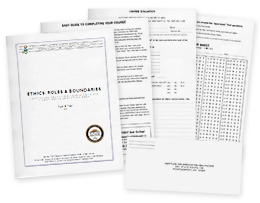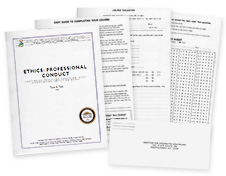

Massage therapists often face interesting ethical dilemmas in the field. Some people bring confounding factors to the treatment table which complicate treatment planning. Other people’s personalities create communication challenges which can be difficult to navigate. Yet others make requests and hold expectations which challenge our professional integrity.
No matter the dilemma, there are important questions to consider with ethical decision making.
Objectively, on paper, it is fairly easy to make determinations as to what is ethical and unethical. However, when people are stricken with an ethical dilemma, one’s mind can freeze as it takes a short while for the gravity of the situation to set in. A therapist can feel overwhelmed with the magnitude of the request and the audacity of a client to make an outlandish request.
The best thing to do in difficult situations is to stop, breathe, and consider questions to remove emotion and provide clarity to any given situation.
6 Essential Questions to Consider
Here are six essential questions to consider that will help one determine the ethical nature of one’s actions in their therapeutic massage practice setting.
1. Does the action keep the focus on safety and well-being of the client?
It is imperative that any decision about a client situation facilitates a safe resolution for both parties. Safety can be defined in both physical and emotional terms, ensuring both parties remain unharmed physically while also ensuring emotional boundaries are maintained.
EXAMPLE: Client requests to be massaged without draping. Therapist needs to maintain professional draping standards to remain ethical.
2. Are you remaining in your scope of practice and level of training?
Many decisions resulting in injury to a client result when a therapist attempts to practice in a manner beyond scope of practice or proper level of training. Be sure to review state laws to determine if a modality or technique is allowed by one’s state massage board. Be sure to ascertain one’s skill set and level of training before attempting new modalities and techniques.
EXAMPLE: Client requests a modality of which the therapist has no knowledge. Therapist must refuse attempting this modality to remain ethical.
3. Are you being respectful of the power imbalance? Are you using this power imbalance to your own benefit?
Be sure to examine whether a client is able to respond to a situation properly by allowing them the space and freedom to express as needed. Be aware to not overtly use the inherit power differential to create an unethical scenario. Clients are vulnerable physically and emotionally upon the table.
EXAMPLE: A client is expressing feelings of hurt and betrayal by their spouse. Therapist must remain neutral in conversation to remain ethical.
4. Does the action create a dual relationship and make therapeutic boundaries less clear?
Dual relationships are defined as relationships in which multiple roles exist between a therapist and client. In the massage therapy field, it is the responsibility of the therapist to be accountable regarding dual relationships and prevent these from manifesting further.
EXAMPLE: Client requests that, instead of a normal monetary tip, that they take the therapist to dinner instead. Therapist must refuse this invitation to remain ethical.
5. Does the action remain within the original contract with your client? Are you honoring the treatment plan, informed consent and/or client policy statement?
Clients agree to a certain set of expectations with sessions with the therapist. Once a therapist deviates from the original expectations agreed upon, decisions become skewed leading to unsatisfied clients who lose trust in their therapist to make ethical choices with treatments.
EXAMPLE: Therapist decides to change modalities offered in the midst of client treatments. Therapist needs to allow client the chance to consent or object to the changes to remain ethical.
6. Could the action lead to future breakdowns of the client-therapist relationship?
Even if an action seems innocuous, long-lasting negative effects can manifest if a therapist knowingly conducts themselves in an unethical manner. The breakdowns deteriorate trust.
EXAMPLE: Therapist states to a client they do not work past a certain evening time, yet allows other clients to be seen after this stated time. Therapist needs to maintain fairness with all clients regarding hours of operation to remain ethical.
Reviewing answers to these questions with a trusted mentor, colleague or former instructor can help bring clarity to one’s mind. Having a listening ear provides an alternative perspective the therapist may not be able to see on their own accord.
Transference and Counter-Transference
A reminder on transference and counter-transference is prudent.
- Transference is the displacement or transfer of feelings, thoughts and/or behaviors related to a significant person or event onto someone else, such as a therapist. Signs of transference include clients: bringing gifts to sessions, asking deeply personal questions, inviting therapist to social events and dates, challenges a therapist’s personal and professional boundaries, and requesting more time and feeling hurt when this request is not granted.
- Counter-transference is displacement or transfer of feelings, thoughts and/or behaviors related to a significant person or event onto a client by a therapist. Signs include therapists: possessing unusually strong feelings (either positive or negative) towards a client, making exceptions for inappropriate behavior, soliciting advice from a client, bending personal and professional boundaries, and treating a particular client differently from all others.
The conscious transfer taking place between therapist and client in either instance can create an emotional response which may hinder healthy decision making. Pausing to recognize if either transference or counter-transference is occurring is a necessary step to ensuring decisions are made from an ethical, objective standpoint.
Boundaries
Ultimately, ethical dilemmas become a challenge to boundaries held by both clients and therapists.
Boundaries are physical and nonphysical limits determined by individuals to ensure security, safety and well-being. Therapists must be conscious of boundaries when interacting with clients. Awareness is crucial in understanding boundaries created by clients. Boundaries will not be equal among all clients. Some clients may not mind if you stand 2 feet away from them; however other clients will think you are smothering them physically by standing too closely.
From where do boundaries stem? For some clients, boundaries arise from sensitivity to what is perceived within the client’s aura fields. For others, past experiences shape boundaries.
Client’s perceptions of their environment create boundaries. Is the massage therapist aware of how their environment will be perceived? Does the therapist’s workspace and décor create boundaries? Does the therapist’s body language, appearance, and speech test client boundaries? All these questions are important to consider when examining the nature of boundaries held.
Conclusion
As a therapist facilitates ethical decision-making from a proper mental space of clarity, the therapeutic relationship becomes paramount. This is the framework of communication and professional ethics with our clients. Our responsibility as massage therapists is to aid in facilitating a client’s healing journey.
As the practitioner learns to exemplify this relationship, the level of professionalism will enhance while the client-therapist bond grows stronger. Client trust increases while therapists have greater awareness in ensuring decisions are made from the utmost professional ethics.














